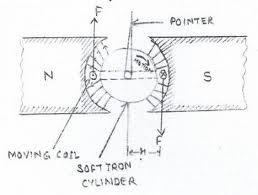PMMC Instruments:These instruments are used either as ammeters or voltmeters and are suitable for d.c work only. PMMC instruments work on the principle that, when a current carrying conductor is placed in a magnetic field, a mechanical force acts on the conductor.
The current carrying coil, placed in magnetic field is attached to the moving system. With the movement of the coil, the pointer moves over the scale to indicate the electrical quantity being measured. This type of movement is known as D’ Arsenoval movement.
PMMC Instruments Construction


It consists of a light rectangular coil of many turns of fine wire wound on an aluminium former inside which is an iron core as shown in fig.
The coil is delicately pivoted upon jewel bearings and is mounted between the poles of a permanent horse shoe magnet. Two soft-iron pole pieces are attached to these poles to concentrate the magnetic field.
The current is led in to and out of the coils by means of two control hair- springs, one above and other below the coil, as shown in fig (b). These springs also provide the controlling torque. The damping torque is provided by eddy currents induced in the aluminium former as the coil moves from one position to another.
Working of PMMC Instruments
When the instrument is connected in the circuit to measure current or voltage, the operating current flows through the coil.
Since the current carrying coil is placed in the magnetic field of the permanent magnet, a mechanical torque acts on it.
As a result of this torque, the pointer attached to the moving system moves in clockwise direction over the graduated scale to indicate the value of current or voltage being measured.
This type of instruments can be used to measure direct current only. This is because, since the direction of the field of permanent magnet is same, the deflecting torque also gets reversed, when the current in the coil reverses.
Consequently, the pointer will try to deflect below zero. Deflection in the reverse direction can be prevented by a “stop” spring.
Deflecting torque equation
The magnetic field in the air gap is radial due to the presence of soft iron core. Thus, the conductors of the coil will move at right angles to the field. When the current is passed through the coil, forces act on its both sides which produce the deflecting torque.
Let, B = flux density, Wb/m2
l = length or depth of coil, m
b = breadth of the coil.
N = no. of turns of the coil.
If a current of ‘I’ Amperes flows in the coil, then the force acting on each coil side is given by,
Force on each coil side, F = BIlN Newtons.
Deflecting torque, Td = Force × perpendicular distance
= (BIlN) × b
Td = BINA Newton metre.
Where, A = l × b, the area of the coil in m2.
Thus, Td α I
The instrument is spring controlled so that, Tc α θ
The pointer will comes to rest at a position, where Td =Tc
Therefore, θ α I
Thus, the deflection is directly proportional to the operating current. Hence, such instruments have uniform scale.
Advantages of PMMC Instruments
a) Uniform scale.ie, evenly divided scale.
b) Very effective eddy current damping.
c) High efficiency.
d) Require little power for their operation.
e) No hysteresis loss (as the magnetic field is constant).
f) External stray fields have little effects on the readings (as the operating magnetic field is very strong).
g) Very accurate and reliable.
Disadvantages of PMMC Instruments
a) Cannot be used for a.c measurements.
b) More expensive (about 50%) than the moving iron instruments because of their accurate design.
c) Some errors are caused due to variations (with time or temperature) either in the strength of permanent magnet or in the control spring.
Applications of PMMC Instruments
a) In the measurement of direct currents and voltages.
b)In d.c galvanometers to detect small currents.
c)In Ballistic galvanometers used for measuring changes of magnetic flux linkages.
………………………………………………………………………………………………….. Reference:-
(i) A.K Sawhney, Electrical and Electronic Instrumentation and Measurements, page no:- 294
(ii) V.K Mehta, Rohit Mehta,Basic Electrical Engineering, page no:- 775-777
…………………………………………………………………………………………………………….
Join EEE Made Easy Whatsapp Channel
- [PDF]Electrical Measurements Measuring Instruments Study Notes PDF|EMMI Notes EEE Made Easy
- MCQ on Electrical Instruments
- Types of Errors in Instruments| Instrument Errors
- MCQ’s on Electrical Measuring Instruments|Instruments Objective Questions
- Electrical measuring instruments|Types of Measuring Instruments
- Static characteristics of instruments
- Types of measuring instruments- www.eeemadeeasy.com
- Moving Iron Instruments
- Instruments- Basics
- PMMC Instruments
- Types of instruments
- Essentials of Indicating instruments
- MCQ’s on Galvanometer|Galavnometer Questions & Answers
- MCQs on potentiometer|potentiometer Questions and answers
- TOD Meter or Time of Day Meter
- Light meters or illumination meter|Lux meter
- VU and decibel meters
- Multimeter- Principle and operation
- Digital readout meters-principle and operation
- Watt-hour meters- principle and operation
- Wattmeter -principle and working
- FET and vacuum-tube voltmeters
- Ohmmeter- basic principle and working
- Ammeters|Current Measurement
- Voltmeter- Principle and operation
- The household energy meter is
- Q Meter
- Thermistor| What is a Thermistor
- RTD vs Thermistor|Comparison between RTD and Thermistor
Latest Posts in EEE Made Easy
- Environment MCQ for RRB JE CBT 2|Objective Questions Environment for Competitive Exams
- RRB JE CBT 2 Computer Awareness Book Arihant|Objective Computer Awareness Book 2025
- RRB JE CBT 2 Exam Date 2025 Postponed|RRB JE CBT 2 Exam Date
- [PDF]RRB JE Result 03/2024 Cut off, Selected no of candidates for all regions
- [PDF]Final Answer Key Junior Instructor Mechanic Agricultural Machinery|643/2023 Solved Question paper
- Acoustics MCQs|Industries Extension officer|IEO 2025
- LASER MCQs| Industries Extension officer|IEO 2025




